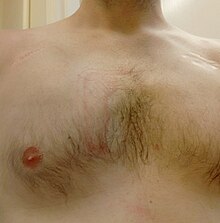
Back تقويم نظم القلب Arabic Cardioversió Catalan Kardioverze Czech Kardioversion German Desfibrilación y Cardioversión eléctrica Spanish کاردیوورژن Persian Cardioversion French היפוך חשמלי HE Cardioversione Italian カルディオバージョン Japanese
This article needs more reliable medical references for verification or relies too heavily on primary sources. (January 2022) |  |
| Cardioversion | |
|---|---|
 Illustration of cardioversion | |
| Specialty | Cardiology |
| ICD-9-CM | 99.6 |
| MeSH | D004554 |
| MedlinePlus | 007110 |
Cardioversion is a medical procedure by which an abnormally fast heart rate (tachycardia) or other cardiac arrhythmia is converted to a normal rhythm using electricity or drugs. Synchronized electrical cardioversion uses a therapeutic dose of electric current to the heart at a specific moment in the cardiac cycle, restoring the activity of the electrical conduction system of the heart. (Defibrillation uses a therapeutic dose of electric current to the heart at a random moment in the cardiac cycle, and is the most effective resuscitation measure for cardiac arrest associated with ventricular fibrillation and pulseless ventricular tachycardia.[1]) Pharmacologic cardioversion, also called chemical cardioversion, uses antiarrhythmia medication instead of an electrical shock.[2]

- ^ Marino PL (2014). Marino's the ICU book (Fourth ed.). Wolters Kluwer Health/Lippincott Williams & Wilkins. ISBN 978-1451121186.
- ^ Shea JB, Maisel WH (November 2002). "Cardiology patient pages. Cardioversion". Circulation. 106 (22): e176–e178. doi:10.1161/01.CIR.0000040586.24302.B9. PMID 12451016.
© MMXXIII Rich X Search. We shall prevail. All rights reserved. Rich X Search